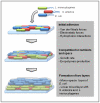Discriminating multi-species populations in biofilms with peptide nucleic acid fluorescence in situ hybridization (PNA FISH)
- PMID: 21479268
- PMCID: PMC3066202
- DOI: 10.1371/journal.pone.0014786
Discriminating multi-species populations in biofilms with peptide nucleic acid fluorescence in situ hybridization (PNA FISH)
Erratum in
- PLoS One. 2013;8(6). doi:10.1371/annotation/2b7e391f-b0cb-4d9f-8e90-85d080f8cbd4
Abstract
Background: Our current understanding of biofilms indicates that these structures are typically composed of many different microbial species. However, the lack of reliable techniques for the discrimination of each population has meant that studies focusing on multi-species biofilms are scarce and typically generate qualitative rather than quantitative data.
Methodology/principal findings: We employ peptide nucleic acid fluorescence in situ hybridization (PNA FISH) methods to quantify and visualize mixed biofilm populations. As a case study, we present the characterization of Salmonella enterica/Listeria monocytogenes/Escherichia coli single, dual and tri-species biofilms in seven different support materials. Ex-situ, we were able to monitor quantitatively the populations of ∼56 mixed species biofilms up to 48 h, regardless of the support material. In situ, a correct quantification remained more elusive, but a qualitative understanding of biofilm structure and composition is clearly possible by confocal laser scanning microscopy (CLSM) at least up to 192 h. Combining the data obtained from PNA FISH/CLSM with data from other established techniques and from calculated microbial parameters, we were able to develop a model for this tri-species biofilm. The higher growth rate and exopolymer production ability of E. coli probably led this microorganism to outcompete the other two [average cell numbers (cells/cm(2)) for 48 h biofilm: E. coli 2,1 × 10(8) (± 2,4 × 10(7)); L. monocytogenes 6,8 × 10(7) (± 9,4 × 10(6)); and S. enterica 1,4 × 10(6) (± 4,1 × 10(5))]. This overgrowth was confirmed by CSLM, with two well-defined layers being easily identified: the top one with E. coli, and the bottom one with mixed regions of L. monocytogenes and S. enterica.
Significance: While PNA FISH has been described previously for the qualitative study of biofilm populations, the present investigation demonstrates that it can also be used for the accurate quantification and spatial distribution of species in polymicrobial communities. Thus, it facilitates the understanding of interspecies interactions and how these are affected by changes in the surrounding environment.
Conflict of interest statement
Figures








References
-
- Costerton JW, Cheng KJ, Geesey GG, Ladd TI, Nickel JC, et al. Bacterial Biofilms in Nature and Disease. Annual Review of Microbiology. 1987;41:435–464. - PubMed
-
- Mah TF, O'Toole GA. Mechanisms of biofilm resistance to antimicrobial agents. Trends Microbiol. 2001;9:34–39. - PubMed
-
- Hall-Stoodley L, Costerton JW, Stoodley P. Bacterial biofilms: From the natural environment to infectious diseases. Nature Reviews Microbiology. 2004;2:95–108. - PubMed
-
- Murray TS, Egan M, Kazmierczak BI. Pseudomonas aeruginosa chronic colonization in cystic fibrosis patients. Current Opinion in Pediatrics. 2007;19:83–88. - PubMed
-
- Parsek MR, Singh PK. Bacterial biofilms: An emerging link to disease pathogenesis. Annual Review of Microbiology. 2003;57:677–701. - PubMed
Publication types
MeSH terms
Substances
LinkOut - more resources
Full Text Sources
Molecular Biology Databases
Research Materials

